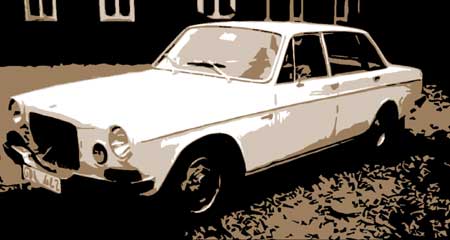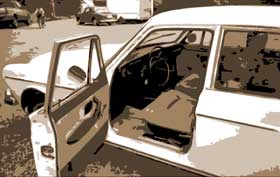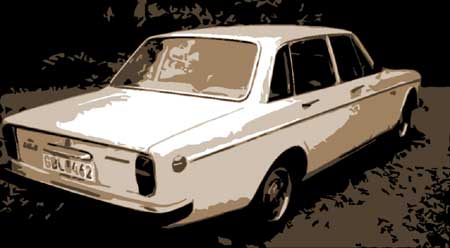Buzz Aldrin's 164
Mark Hershoren
foreignaffairsdesk@vclassics.com
Some would say visiting a foreign country is akin to visiting another world. And then there are those who actually have visited another world.
On visiting the moon the Lunar Module was driven on the green cheese of that sphere's surface, but when Buzz Aldrin paid a visit to Sweden, his spaceship was a shiny new Volvo 164S. In the year following the famous moon walk, in the summer of 1970, Aldrin visited Sweden and had use of an early example of the late 1960s Volvo flagship.

Bilkompanient (literally the "Automobile Company") in Eskilstuna delivered this particular new car to Nya AB Engdals Färg, a company whose business was paint. The car was kept for less than two years and traded in, presumably for a new vehicle. It's unclear whether the car was the property of the paint company or had been back in possession of the dealer at the time of Aldrin's use. A Swedish car featuring a six-cylinder engine coupled with an automatic transmission was considered a fairly luxurious conveyance in many social circles of the homeland, and it appears that Aldrin was treated very kindly during his visit -- certainly to the extent that he was provided with the finest modern automobile built in Sweden at the time.
The next documented change of possession came when a school director named Sven Huselius purchased the car, then showing 23,000 kilometers on its odometer. The date of purchase: December 16th of 1970. Huselius retained the 164 until the time of his death in 1984. His widow Aina kept the car another ten years, continuing her late husband's practice of lavishing a high degree of care on it, parking it in a heated garage, and driving very infrequently during the winter months.
Word of mouth about the car's existence spread among a number of people, and when it finally reached Per Thyrén's ears, he knew he had to have it. Almost 24 years passed from the time the old school director had purchased the slightly-used 164 with a noteworthy history to the day in November of 1994 when Thyrén purchased the Volvo from Mrs. Huselius.
This very same car is now offered for sale by Per Thyrén and can be seen on his web site (home.swipnet.se/thyren)
Roots of a New Flagship
Volvo had produced six-cylinder powered automobiles for the better part of 30 years when the 800 series, a large four-door vehicle suited to both taxi and VIP use, was finally terminated in 1958. The ageing model in its final incarnation had the frontal appearance of a swollen 544, but from the windshield rearward the car was not unlike cars those produced in the late 1930s. Under the hood, a flathead six-cylinder lurked. The passing of the "Sow," as it was nicknamed with typical wry Swedish humor, was fairly universally mourned.
Recognizing the need to have a new prestige model in the lineup, designers and engineers began working on the new "big" Volvo, code named P358, in March of 1958. Initial specifications called for a 3.6 liter pushrod V8 developed previously for the stillborn Philip project. Ultimately never used for automobiles, the V8 finally saw use in truck applications.
The car would be equipped with front disc brakes, column-mounted gear shift and live rear axle later to be fitted with pneumatic suspension. Provisions would be made to fit a partition if the car was to be used as a taxi. By May of 1960, management scratched plans to use the V8 after witnessing the growing U.S. demand for compacts.  It was decided that a six-cylinder engine would be a better alternative in terms of production expense. It was decided that a six-cylinder engine would be a better alternative in terms of production expense.
Projections showed that production of this elegant car could begin as soon as the mid-1960s, but fears that the car would not sell in numbers necessary to justify its production caused several years worth of work to be shelved. What if the P358s were larger than what the buying public was looking for?
In June of 1960 other planners were working on what would in late 1966 become the 140 series. As this launch drew near, thoughts returned to the lessons learned in the design of the P358. The demand for larger cars was beginning to return, and Jan Wilsgaard, along his team of designers, found they could combine the front end of the P358 to the slightly lengthened front of a 140 and produce an attractive luxury car. With this, the 164 was born and slated for introduction to its public in late 1968.
The new engine was a 2978cc six designated the B30. The seven-bearing crankshaft carried pistons of the same dimension as the new 2 liter four-cylinder B20, hence pistons and some of the valve train were shared between both the four and six. With twin side-draft Stromberg carburetors, the engine was rated at 145 horsepower. In certain markets, as well as in marine applications, the engines were trimmed to produce something closer to 180 HP.
Both Borg-Warner automatic and ZF manual transmissions were offered, the latter available with an optional Laycock DeNormanville overdrive.
Although eventually standard on the U.S. market, power steering was initially an option. It became standard by the time the '71s had been introduced. This was in parallel with the lengthening of the wheelbase of both 140 and 160 cars by 2cm. Wider wheels appeared at this time. Bosch D-Jet fuel injection was also being phased in to replace the Strombergs.
The interior was considered quite plush by Volvo standards. The earliest 164s were delivered with cloth upholstery, but by '69 this was relegated to an alternative and leather became the more typical appointment. The faux wood treatment on the dash panel shared with the new 140 series was among the very few disappointments cited by those critical of the car.
By the time Volvo retired the 164 in 1975, some 153,000 of them had been made. Along the way, minor changes to accommodate federal regulations dictated a heavier bumper which ran straight across the front, making the face less elegant, while in some markets including the U.S., occupants could enjoy amenities like power sunroofs and door glass, reading lamps and such. A sturdy, diligent car of understated plushness, the 164 bowed out to make way for a car which was to develop both a small following and no small amount of infamy: the 264... but that's a story for another day.

Illustrations styled from photos provided by Per Thyrén
|
